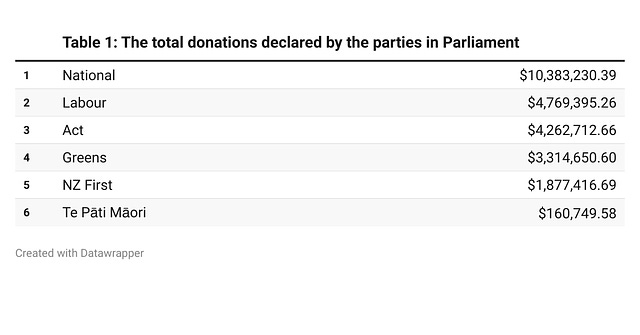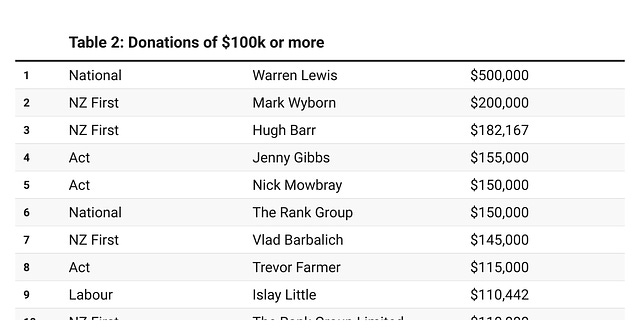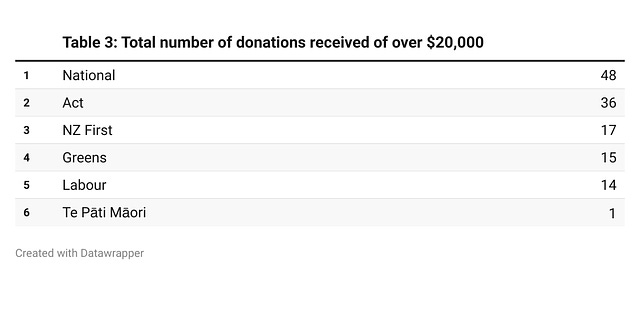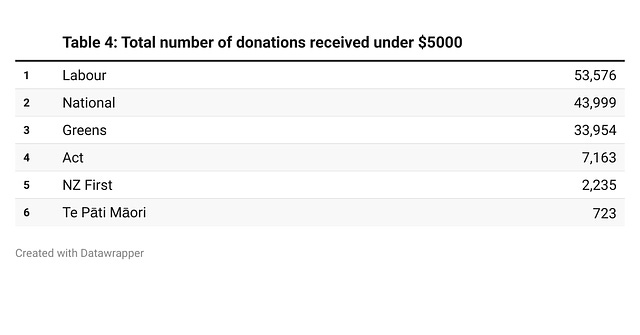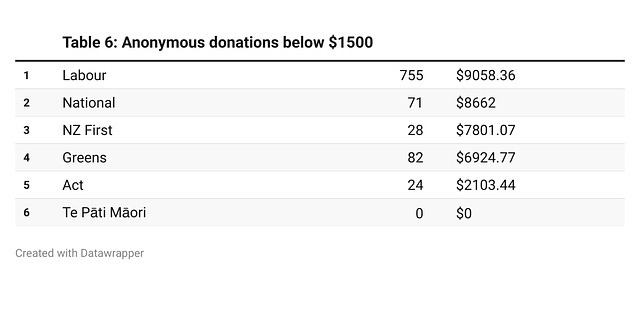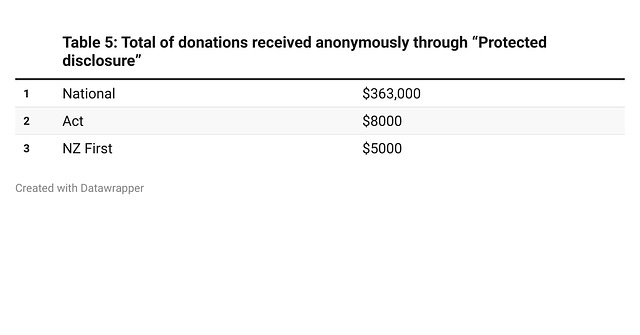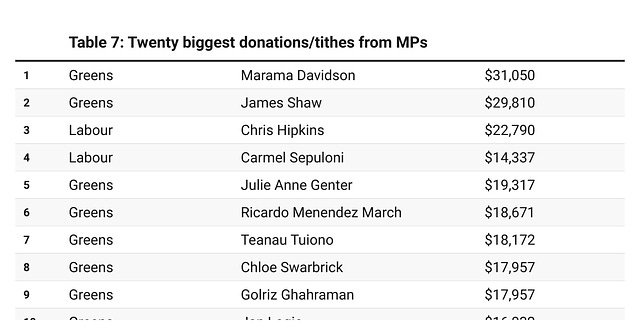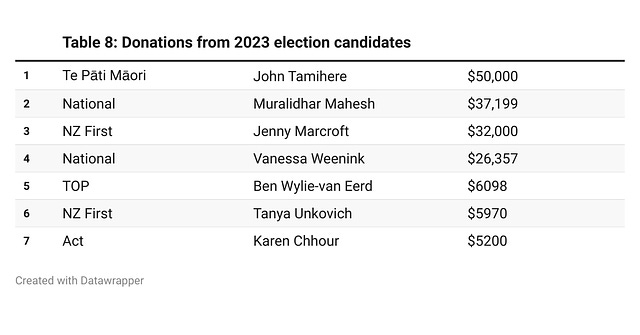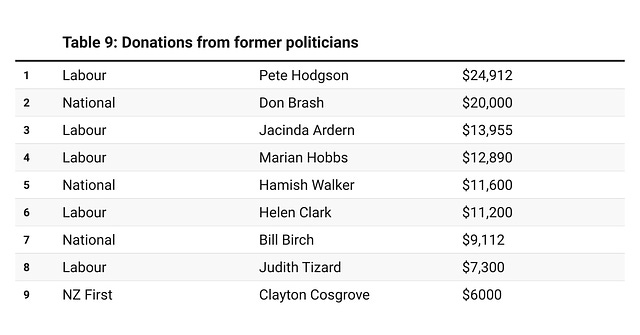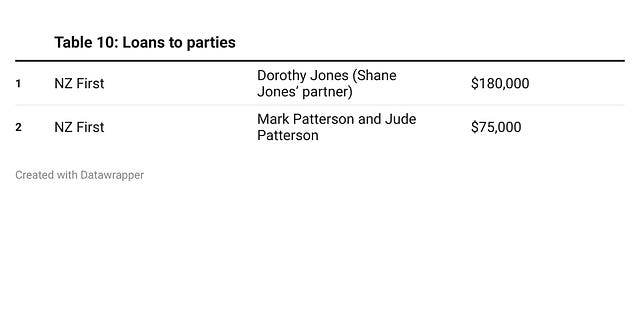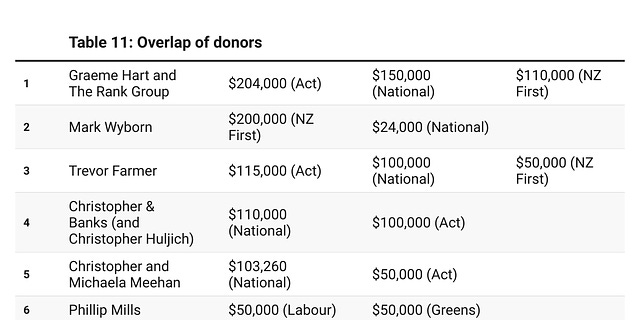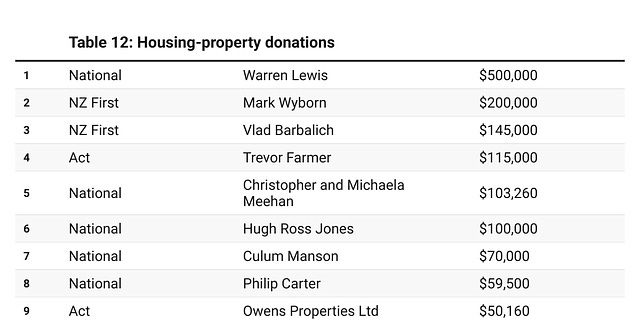Analysis by Dr Bryce Edwards – Democracy Project (https://democracyproject.nz)

“Follow the money” is the classic directive to journalists trying to understand where power and influence lie in society. In terms of uncovering who influences various New Zealand political parties and governments, it therefore pays to look at who is funding them.
The political parties are legally obliged to make declarations about the donations they’ve received each year. They pass this information on to the Electoral Commission, and the donations from the 2023 year have now been published on the Commission’s website.
Below are the aggregated total donations for each party elected to Parliament last year. The total donations received by these parliamentary parties were nearly $25m. Of this total, the parties of the new government (National, Act, and NZ First) received 16.5m, and the parties of the Opposition (Labour, Greens, Te Pati Māori) received the lesser amount of about $8.2m.
Huge totals of donations received
National has declared a total of $10.4m of donations for the 2023 election year – which has captured media headlines about the release of the donations declarations. Journalists reporting on this have used the terms: “staggering” (Stuff), “enormous” (Newshub), and “massive” (The Herald and Newsroom).
The $10.4m raised is indeed significant and illustrative of just how popular the National Party is at the moment with wealthy individuals and companies. However, some caution is also required in the interpretation. For example, some reports have compared the $10.4m figure with smaller totals that National have received in the past, suggesting a significant increase in funding for National. But this is a case of apples being compared to oranges.
The reporting rules have changed significantly for the 2023 election-year donations. Whereas previously, the parties were legally required to declare donations of $15,000 or more, this threshold has now been considerably lowered to include any donations over $5000. This means National’s donation reporting captures many more donations than in the past.
Furthermore, parties also now have to report on the quantum of donations received that are below the declaration threshold. For 2023, National has declared about $6m of below-$5000 donations. The larger donations only make up about $4m, or about 40 per cent, of National’s declaration.
The $10.4m raised by National is still highly significant and note-worthy. However, there should also be caution with the claim made in the media in the last few days that this figure is the largest ever received by a party in New Zealand’s political history. It’s worth noting that at the 1987 general election, the Labour Party of David Lange and Roger Douglas received about $3.5m in donations. When this figure is translated into 2023 dollars, it’s about the same as National received last year.
Large donations
The 2023 election year certainly contained quite a few huge donations from wealthy individuals and companies. By far the biggest was the $500,000 donated to National by business owner Warren Lewis. Although this has been reported to be the largest recorded donation given to a political party, back in 2005, businessman Owen Glenn infamously gave $500,000 to the Labour Party.
The second-largest donation was $200,000 given by property developer Mark Wyborn to New Zealand First.
National also received a $200,000 donation from Buen Holdings, which is owned by Guemsoon Shim and Lian Seng Buen. However, the records state that this was received on 10 August last year, but it was then returned to the donor on 23 August – the same day that the donors were in the news for a story about the Auckland Council and Tenancy Services investigating alleged unlawful tenancy management in one of their buildings.
The table below lists the biggest donations received.
While the above table includes all the donations of $100,000 or more, it’s also worth noting the amount of lesser amounts. Taking an arbitrary threshold of $20,000, the following table shows how many medium-sized donations the parties have received.
It’s also useful to look at how many large donations each party received. If you take an arbitrary threshold such as $20,000, the list below shows how many large donations above this figure were received by each party.
Once again, of these 131 medium-sized donations, most have gone to the parties of the new government (101), and few have gone to the parties in opposition (30).
Donations under $5000
In the past, parties only had to declare donations over a certain threshold (which has been $15,000 in recent years). But now parties also must account for donations under $5000. Rather than detailing each donation and the identities of the donors, the parties simply declare how many such donations they have received and what the aggregated amount of money is. The total number of sub-$5000 donations received by each party is below.
The donations below $5000 appear to make up the vast bulk of money received by the parties. As already mentioned, 60 per cent of National’s donation income in 2023 came from these smaller donations, and for some of the other parties, it is even higher. Interestingly, the parties of the opposition, in particular, have received more of the smaller donations (88,253) than those of the government parties (53,397).
Anonymous donations
Political parties’ ability to receive anonymous donations has been clamped down. Parties can now only receive such donations in two highly regulated ways.
Firstly, parties are only allowed to accept anonymous donations of less than $1500. The table below shows how many such donations each party received in 2023 and the total amounts of these donations for each party.
Donations can also now be given anonymously to political parties by sending the money to the Electoral Commission, which then passes the money onto the parties without any identities attached. These are called “Protected donations”, and the Electoral Commission is only allowed to distribute a maximum of $373,520 to any one party in a year. Below is the list of protected donations passed onto the parties.
In 2023, there were only eight such donations, six of which went to National, totalling $363,000 (just below the allowable limit). NZ First and Act received one protected donation each. This information can be seen in the table below.
MP donations
Parties raise much of their income from MPs’ high parliamentary salaries. Some parties, traditional on the left, have a “tithing” rule in which roughly ten per cent of their MP or Ministerial salaries are donated to the party.
Such tithing didn’t always appear in the Electoral Commission records – because, in the past, when the threshold for disclosure was higher, many of the MP tithing amounts were lower than needed to be declared. But in 2023, all the tithes for Labour and Green MPs were published. See the table below for the biggest MP levies in 2023.
Donations from election candidates
The records of donations released by the Electoral Commission include some curious donors – the candidates themselves running for Parliament. It’s pretty standard for party organisations to raise money to give to candidates to help their local election campaigns, but in this case, some of the candidates have also been making donations to the head office.
The most prominent example in the table below is the $50,000 given to Te Pati Māori by list candidate John Tamihere, however in his case, he’s also the President of the party. Just as Tamihere didn’t make it into Parliament, National’s Auckland Central candidate Muralidhar Mahesh – who donated $37,199 – also missed out, along with TOP donor-candidate Ben Wylie-van Eerd ($6098). More successful were Jenny Marcroft ($32,000) for NZ First, Vanessa Weenink ($26,357) for National, Tanya Unkovich ($5970), and Karen Chhour ($5200) for Act.
Donations from former politicians
It’s normal for political parties to seek extra fundraising from former MPs, especially those in retirement who might have accumulated decent fortunes from their time in politics and afterwards. While the example in the table below of Clayton Cosgrove’s consultancy firm giving $6000 to NZ First is the smallest, it’s possibly the most interesting, given that Cosgrove is a retired Labour MP.
Loans to political parties
Although donations to parties have been regulated for decades, the loans provided to politicians have often flown under the radar, even though such loans have in the past been written off. Loans can often turn into donations, so they are now required to be disclosed. But in 2023, only two loans were disclosed, and they were both given to the NZ First party from the families of candidates—see the table below.
Donors giving to multiple parties
Several donors have given to more than one political party. Clearly, some donors wish to support many different parties on the same side of the political spectrum. Hence, New Zealand’s richest man, Graeme Hart and his company The Rank Group, gave $204,000 to Act (in separate donations), $150,000 to National, and $110,000 to NZ First – all totalling $464,000.
Another Richlister, Trevor Farmer, gave $115,000 to Act, $100,000 to National, and another $50,000 to NZ First.
AJR Finance has only given to two of the new Government coalition partners: $55,000 to NZ First and $20,000 to National.
Another company, Christopher & Banks, gave National and Act $100,000 each. The private equity firm is run by Christopher Huljich, who gave National another $10,000.
Property developers Christopher and Michaela Meehan have given $103,260 to National and another $50,000 to Act. Similarly, Wellington’s Chris Parkin gave $24,500 to National and $10,000 to Act.
Wellington businessman Troy Bowker – a previous donor to Labour’s Stuart Nash – gave $15,000 to Act and $10,000 to NZ First.
On the left, gym company boss Phillip Mills gave $50,000 both to Labour and the Greens. Similarly, property developer Mark Todd gave $50,000 to Labour and $20,000 to the Greens.
Housing property donations
A large number of donors appear to be involved in the housing and property development industry. These donations have featured particularly strongly in the declarations from the parties now in government.
The largest donation of the year – $500,000 from Warren Lewis – is not directly involved in property but the wider construction industry. Lewis’ business, FMI Building Innovations, is described as a “building systems and materials supplier”.
Various property developers have made some large donations. For example, Mark Wyborn has given $200,000 to NZ First and $24,000 to National. His business partner Trevor Farmer has given $115,000 to Act and $100,000 to National.
Property developer Winton is partly owned by CEO Chris Meehan and his wife Michaela Meehan. Together, they donated $103,260 to the National Party in 2023. In addition, Chris Meehan donated $50,000 to Act. Christchurch property investor Philip Carter donated $59,500 to National.
One of the largest private developers in New Zealand, Manson TCLM, is partly owned by Culum Manson, who gave $70,000 to National. Real estate boss Garth Barfoot, a long-time National donor, gave $20,000. National received a further $22,000 from Auckland commercial landlord Andrew Krukziener, who also donated $19,999 to NZ First.
NZ First also received $145,000 from Wellington property developer Vlad Barbalich.
One of the more interesting property developers, Ockham Residential, appears to have hedged its bets with political donations. Owner Mark Todd gave $50,000 to Labour and $20,000 to the Greens. The company’s Chief Executive, William Deihl, gave a further $20,500 to National.
Mismatch between donations and spending
The $25m declared in donations by the parties in Parliament for 2023 was obviously used for fighting that year’s general election. However, caution must be taken when comparing the donations and expenditures declared to the Electoral Commission.
At first glance, there might appear to be a major discrepancy between the funding and expenditures. For example, National declared $10.4m in donations but only spent about $3.6m. Labour spent more than this ($4.8m) despite declaring a smaller amount of donations.
The two figures aren’t immediately comparable. First, the spending figures only relate to the 12 weeks before polling day, whereas parties generally spend money on campaigning throughout the year.
Secondly, the spending figures only account for money spent on paid advertising. There are plenty of other party and election expenditures that aren’t captured by the legal declarations – such as money spent on staff and opinion polling.
Further columns will dive deeper into this and look at the donations received by individual parties.
Dr Bryce Edwards
Political Analyst in Residence, Director of the Democracy Project, School of Government, Victoria University of Wellington
This article can be republished for free under a Creative Commons copyright-free license. Attributions should include a link to the Democracy Project (https://democracyproject.nz)



